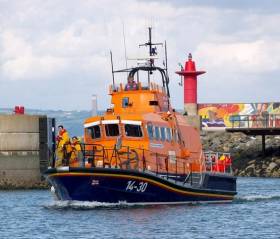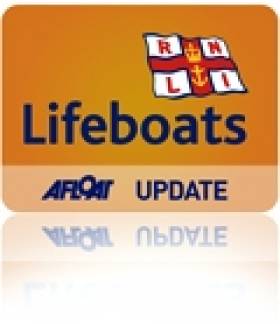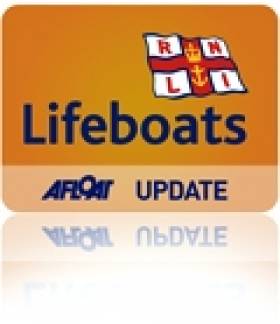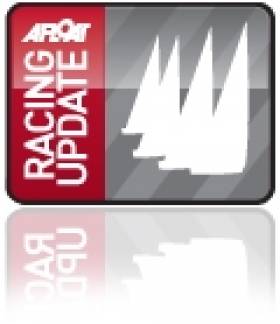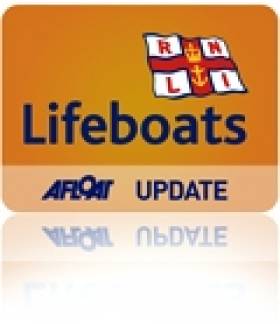Displaying items by tag: Larne
Larne Lifeboat Crew Trains With Dublin Coastguard Helicopter
#RNLI - The RNLI volunteer lifeboat crew from Larne carried out a training exercise with the Dublin-based Irish Coast Guard helicopter Rescue 116 off Ballygally Head yesterday (Sunday 10 April).
The Sikorsky S-92 initially visited Larne on 20 March last when they landed on Curran Point. The visit consisted of a briefing to Larne RNLI crew and included an orientation of the helicopter. The Larne Coastguard team was also present on the day, securing a safe landing zone for the helicopter.
Larne RNLI launched both their relief all-weather lifeboat Windsor Runner and inshore lifeboat Terry yesterday for the exercise to simulate recovery of a casualty to a helicopter in an emergency situation.
The lifeboats practiced manoeuvres at speed with Rescue 116. A crew member was winched into the helicopter and a casualty stretcher was transferred from the helicopter to the lifeboat. The helicopter winchman also landed onto the inshore lifeboat.
The RNLI regularly carries out exercises with other rescue agencies. It is this training that ensures the crew are able to work effectively with other agencies in an emergency situation, including medical evacuation of a casualty to a helicopter.
Larne RNLI coxswain Frank Healy said: "This was a very valuable exercise with the Irish Coast Guard. It's fantastic to step up the volume and breadth of our training coming into what is traditionally a busy summer period for call outs. Our thanks to the Irish Coast Guard for making this exercise possible."
Bangor, Larne & Donaghadee Lifeboats Launch To Air Emergency
#RNLI - Lifeboats from Bangor, Donaghadee and Larne were launched last night (Tuesday 27 October) as part of a major operation after a flight out of Belfast declared an emergency.
Police, fire and ambulance crews were also involved in the cross-agency response to the British Airways flight from Belfast City Airport to Heathrow, with 108 passengers aboard, which diverted to Belfast International Airport shortly after take-off as the pilot declared an emergency.
The RNLI lifeboats were on the water within 10 minutes of receiving a request from HM Coastguard and proceeded to positions which are part of a practiced air emergency plan.
Thankfully the services of the volunteer crews were not required and the lifeboats returned to station within the hour.
Alan Whiteside, operations director at Belfast International Airport, said: "Everything went smoothly, our own police and fire service on site here responded, the Northern Ireland Fire and Rescue Service, the PSNI, the Northern Ireland Ambulance Service all attended as a routine.
"But nobody was required to take any other action - the aircraft landed safely, thankfully."
Larne RNLI Rescues Two Men Lost in Thick Fog
Larne RNLI rescued two men in challenging conditions last night after their 14ft punt got lost in fog.
The volunteer crew was requested to launch their inshore lifeboat by Belfast Coastguard shortly after 8pm following a 999 call.
The men had got into difficulty when they became disorientated in the fog at Swan Island in Larne Lough.
Larne RNLI’s lifeboat helmed by Pamela Dorman immediately made its way to the scene in what were challenging conditions for the crew whose visibility was restricted to three metres.
Once the casualties were located and deemed not to be in any immediate danger, a tow was set up and the lifeboat proceeded to return the vessel and its crew to the safety of Larne Boat Club slipway.
Speaking following the call out, Larne RNLI helm Pamela Dorman said: ‘This was a particularly challenging call out this evening given the fog and the fact that our visibility was reduced to two to three metres. However, we are trained to deal with these situations and with the assistance of Belfast Coastguard and the casualties we were guided to the location and able to return the men safely to shore tonight. The casualties had made the correct decision to raise the alarm and request assistance when they got into difficulty. We would always urge anyone in distress to call 999 and ask for the Coastguard.’
Larne RNLI Launches New Lifeboat
Volunteers, supporters and friends of Larne RNLI gathered this weekend at the East Antrim Boat Club to attend the official Naming Ceremony and Service of Dedication for the lifeboat station’s new D-class lifeboat Terry. The new inshore lifeboat was provided through the Pistol Benefit Fund, which was set up in memory of Frederick (Fred) and Theresa (Terry) Pistol and named Terry in memory of Fred’s beloved wife Theresa.
The Pistol Benefit Fund has its origins in Frederick Pistol’s incredible life. Fred came to the UK from Austria, as a 19-year old refugee fleeing the Holocaust. He arrived with nothing more than the clothes on his back and worked as a fitter until the Second World War started. He joined the army, eventually becoming a Major and returned to England in 1946 after serving abroad. He married Theresa (Terry) a concert pianist born in Westcliff-on-Sea and discovered a passion for sailing, one that has been passed down through the family. Every boat Fred bought was named Terry after his wife and Larne RNLI’s new D-class lifeboat now proudly bears the name.
Attending the ceremony were members of the Pistol family, who have supported the work of the RNLI for many years. Fred and Theresa’s son Neil and his wife Viveca were special guests along with their two sons, Ben and Josh and their friend Simon Perlmutter. Their daughter Gabriella was unable to attend as she is currently travelling but she was being kept up to date with the proceedings by her brothers. Close friends of the couple, Alan and Shirley Shalet, also made the journey on what would have been Fred’s birthday.
Allan Dorman, Larne RNLI Lifeboat Operations Manager, who accepted the lifeboat into the care of the station said; ‘Every naming ceremony for a new lifeboat is a special occasion and this is no exception, as we honour the Pistol family and their generous life-saving gift to the Institution and the people of Larne. We will remember Frederick and Theresa through the work of this lifeboat and the volunteer crew and we will be the proud custodians of it for many years to come.’
Speaking during the ceremony Neil Pistol said, ‘Thank you for honouring my family and allowing me this privilege. Thank you to the RNLI for being there. Thank you for going out into conditions when others are safe in harbour. Thank you for risking your lives to save others. You, all the members of the RNLI, make a difference. You do not discriminate; you solely take action to save others.
Neil also expressed his pleasure on learning, during an earlier tour of the lifeboat station, that the name of the RNLI rescue mannequin, lifeboat crew use during training, is named Fred. He concluded his speech by acknowledging this, to the delight of the crowd;
‘It will bring us all great pleasure to know that in real life as in previous real-life, Terry will continue to rescue Fred, during the station’s regular training sessions. In the end we make our own destiny. Good luck and Godspeed to all the Larne crew. It gives me great pleasure to hand this lifeboat into the care of the RNLI.’
The D-class lifeboat remains the workhorse of the RNLI as it has for nearly 50 years. Built at a cost of £48,000, the inflatable craft is highly manoeuvrable and specifically suited to surf, shallow water and confined locations – often working close to cliffs, among rocks or even in caves. Importantly it can also be righted manually by the crew in the event of capsize.
It is the smallest class in the RNLI lifeboat fleet but its impact on search and rescue has been huge. The D class carries out some of the most difficult and dangerous rescues lifeboat crews have faced.
The platform party at the service were Mr. Tommy Hutcheson, retired Deputy Launching Authority for Larne RNLI who welcomed guests and opened proceedings; Mr Neil Pistol, who presented the RNLI with the new lifeboat, Christopher Brooke, RNLI Irish Council member who accepted the lifeboat on behalf of the RNLI and handed her into the care of the station; Mr. Allan Dorman, Larne RNLI Lifeboat Operations Manager, who accepted the lifeboat on behalf of the station; Darren Byers RNLI Divisional Operations Manager for Northern Ireland and the Isle of Man who spoke on the capabilities of the new lifeboat and Ms Karen Black, one of the founding crew members of Larne RNLI who recently retired and who officially named the lifeboat.
The Very Reverend Aidan Kerr, the Venerable Stephen Forde, Reverend Tommy Stevenson and Reverend Doctor Colin McClure lead the Service of Dedication with specially chosen hymns and readings. Music was provided by
Magheramourne Silver Band.
Last year Larne RNLI celebrated 20 years of lifesaving during which time the volunteer lifeboat crew launched 411 times, saving 31 lives and rescuing 326 people. Larne RNLI operates both a D-class inshore lifeboat and a Trent class all-weather lifeboat.
Holocaust Survivor’s Legacy Helps Fund Larne's New Lifeboat
#RNLI - The Pistol Benefit Fund, set up in memory of Frederick (Fred) and Theresa (Terry) Pistol, has funded the new Larne RNLI D-class lifeboat, which will be named in an official ceremony at the East Antrim Boat Club this Saturday 19 September at 2.30pm.
All are welcome on the day for the decication of the lifeboat, which is to be named Terry in memory of Fred Pistol’s beloved wife Theresa.
The Pistol Benefit Fund has its origins in Frederick Pistol’s incredible life story. Fred arrived in the UK as a 19-year-old refugee fleeing the Holocaust in Austria, with nothing more than the clothes on his back, and worked as a fitter until the Second World War started.
He joined the army, eventually becoming a major, and returned to England in 1946 after serving abroad. He married Theresa, a pianist born in Westcliff-on-Sea, and discovered a passion for sailing, one that has been passed down through the family.
Every boat Fred bought was named Terry after his wife, and Larne RNLI’s new D-class lifeboat will also proudly bear the name.
The Pistol family has supported the work of the RNLI for many years, and Fred and Theresa’s son Neil will attend the naming ceremony in Larne along with his wife Viveca and two of their three children, Benjamin and Joshua.
Other close friends will also be travelling to Larne for the special occasion, which, in a happy coincidence, is being held on the date of Fred’s birthday, something which has delighted the family.
The D-class lifeboat remains the workhorse of the RNLI as it has for nearly 50 years. The inflatable craft is highly manoeuvrable and specifically suited to surf, shallow water and confined locations – often working close to cliffs, among rocks or even in caves. Importantly it can also be righted manually by the crew in the event of capsize.
Equipment includes fitted and hand-held VHF radio, night vision equipment and first aid, including oxygen. It has a maximum speed of 25 knots and can carry three crew members and five survivors.
Allan Dorman, Larne RNLI lifeboat operations manager, said: "We are grateful to the Pistol Benefit Fund for the generous gift which has funded our new lifeboat and we look forward to welcoming Neil and his family, along with friends of the Pistols to Larne.
"The funding that made our new lifeboat possible has come through a wonderful couple with an incredible history. We in Larne RNLI will remember Frederick and Theresa through the work of the lifeboat and the volunteer crew and we will be the proud custodians of it for many years to come."
Larne RNLI Lifeboat Launches to Assist 24ft–Yacht in Difficulty
Lifeboat crew with Larne RNLI launched their all-weather lifeboat this afternoon (Saturday 5 September) at 3.05pm following a report that a 24 ft yacht with three people onboard was in difficulty south of Muck Island. The request to launch was received from Belfast coastguard.
The all-weather lifeboat, Dr. John McSparran, under Coxswain Robert Rice was immediately launched and underway. The yacht with three people onboard was experiencing engine difficulty in challenging conditions.
Once on scene a lifeboat crew member was transferred onboard the yacht and a tow line was set up. Conditions were challenging with winds registering force 6 and a rough sea. The yacht was then towed to safety into Larne lough and secured to a mooring.
Commenting on the callout Larne RNLI Coxswain Robert Rice said, ‘While the yacht was suffering engine difficulties, the weather made the callout extremely challenging. Thankfully an experienced lifeboat crew were on scene to ensure that a tow could be safely established and the vessel brought to safety quickly and with no casualties.’
Busy Sunday Night For Larne Lifeboats
#RNLI - The volunteer lifeboat crew with Larne RNLI had a busy Sunday evening (19 April) when both the all-weather and inshore lifeboats were tasked to two separate incidents within minutes of each other.
The inshore lifeboat was launched to aid a 20-foot rowing boat with two people onboard, which was having difficulty making it to land in Ballygally Bay when it was hit by strong tides.
Meanwhile, the all-weather lifeboat was sent to search Brown’s Bay after reports were received of two canoes washed ashore with nobody on them.
The inshore lifeboat crew were quickly stood down when the two people on the rowing boat managed to make it to shore safely. The crew then immediately proceeded to Brown’s Bay where they joined their all-weather lifeboat crew colleagues in the search for the suspected two missing canoeists.
Both lifeboat crews were stood down around 45 minutes later following a call to Belfast Coastguard by a woman who said the two boys who had been on the canoes had capsized and managed to make it to shore. They were unable to recover their canoes and so the crafts were left on scene. The boys had made it home safely.
Commenting on the callouts, Larne RNLI crew member Pamela Dorman said: "Thankfully both these callouts had a successful outcome but with conditions being choppy with a Force 4m you can never take a chance.
"These types of callouts are always taken seriously by us and treated as missing persons until further information can be obtained. We would like to thank the woman who phoned the coastguard as we were able to recover the craft so that other alerts would not be issued.
"We would always advise people who see something at sea that worries them, to raise the alarm. You never know when a life could depend on it."
Lucky Seven as Larne RNLI Lifeboat Clocks Up the Call Outs
#rnli – The lifeboat crew with Larne RNLI have not had much time to relax over the summer, as their lifeboats have been launched seven times since the end of June. The call outs were to a variety of incidents, including a man in trouble in the water, drifting vessels and false alarms with good intent. Thankfully in all seven call outs there was no serious injury or loss of life and the swift action of the lifeboat crew brought several people to safety.
Commenting on the busy season Larne RNLI volunteer lifeboat crewmember Pamela Dorman said, 'It has been a very busy time for the lifeboat crew in Larne and each call out has been different. We never know what will meet us when we launch at all hours of the day and night but we are prepared for everything.
Even with call outs that have proven to be false alarms with good intent, we would prefer to be called out than to have a serious incident missed that could have been prevented. It may even mean a life saved.'
A look back at the last few weeks with Larne RNLI have shown a variety of call outs:
On Friday 25 July Larne inshore lifeboat was launched at 6.11pm to reports of a 27ft Bayliner broken down in Ballygally Bay with two people onboard. The lifeboat crew established a tow, but due to the weight of the boat and the distance to be travelled, they also called on the all-weather lifeboat to assist. Between the two lifeboats the vessel was towed to Glenarm Marina. Larne Coastguard assisted the lifeboat crew by securing boat in the marina.
On Tuesday 22 July Larne's inshore lifeboat was launched on service at 12.40am to a man reported to be in the water. Once on scene the lifeboat crew safely recovered the casualty onboard and asked for an ambulance to meet them at the shore as he had been in the water for 45 minutes. The lifeboat brought the casualty ashore where he was handed into the care of Northern Ireland Ambulance Service and Police Service of Northern Ireland. Larne Coastguard was also in attendance.
On Sunday 20 July Larne All-Weather lifeboat was returning from exercise when they were diverted to a broken down 32ft sailing boat with two people on board in Ballygally bay at 11.12am. There was no wind so the sailing boat was beginning to drift and unable to make its way safely. Larne All-Weather lifeboat took the sailing vessel under tow and brought it to East Antrim Boat Club where it was placed on a mooring.
On Tuesday 15 July the inshore lifeboat was launched to Browns Bay at 5.11pm to what was thought to be two people in the water after a small boat had sank. The inshore lifeboat along with Portmuck coastguard searched the bay and made contact with other boat users who may have seen a small boat sinking in the area. With the area well searched and no one seeing any other boats in the area it was decided that the first informant mistook two lobster buoys for two persons and was a false alarm with good intent.
On Monday 14 July the inshore lifeboat at 1135am to a kayaker struggling to make way off skernoghan point at Islandmagee. When on scene the casualty was found to be very tired from paddling against the tide and a strong wind. He was brought ashore by the lifeboat crew.
On Saturday 12 July Larne RNLI's inshore lifeboat launched at 8.02am to reports of a small grey tender drifting south from Muck Island. The lifeboat crew searched from Portmuck to blackhead lighthouse with Portmuck coastguard searching from the Gobbins cliffs. Bangor RNLI was also tasked to help with the search and they searched north from Bangor to blackhead. Portmuck Coastguard then spotted the tender over two miles north from the shore and directed the lifeboats towards it. When on scene it was established that there was no-one on the tender and it was confirmed it had broken free from a yacht the night before. Larne inshore lifeboat crew took the tender in tow and Bangor lifeboat returned home. Larne RNLI reunited the tender to the owner and returned to station.
On Saturday 28 June Larne's inshore lifeboat launched at 2.20pm to help administer first aid to a man taken ill on browns bay beach. An ambulance was also called. The lifeboat crew was on scene at 2.27pm along with Portmuck Coastguard. However on arrival the casualty could not be located and the RNLI and Coastguard teams searched the beach and surrounding area. When nothing was found all units were stood down and it is believed the man had recovered and made his way home.
The Chase Race, A Circumnavigation of Larne Lough
RES, one of the world's leading independent renewable energy project developers, with a base in Larne, Co Antrim have been installed as key sponsors for the forthcoming Meningitis Chase Race day.
The race, which has also been billed as 'the great circumnavigation of Larne Lough' is attracting huge interest from the Irish dinghy world. It is pursuit type event which actually consists of two races – a junior race followed by the main race in the afternoon.
To be held on Saturday 7th September, and organised by East Antrim Boat Club the event will provide racing for mono-hulled dinghies, day-boats and sports-boats having a Portsmouth Yardstick number between 1600 and 900. The 'junior race' of 50 minutes will be run for those boats with a PY between 1600 and 1180. However the main race, The Chase Race, will provide staggered starts for boats with a PY between 1180 and 900. This race will run for 100 minutes.
The event is being organised in the memory of Stan Jobling (3) who was so tragically taken by this horrendous disease. The Jobling family who are the driving force behind this novel event, have set themselves two objectives: To raise at least £1,000 for the Meningitis Trust and, have provided a spectacle of some 50 assorted sailboats lined around the shoreline of this beautiful Northern Ireland Lough. A live dinghy show...
Victoria Graham, Community Relations Manger with RES said, "We are delighted to support this local event in memory of Stan Jobling. The event will be a fantastic tribute to Stan and will be a great spectacle on the Lough. Even those without sea legs should come along and support the competitors and soak up the atmosphere on what I'm sure will be a great day out for everyone!".
Notice of Race and Entry Forms are now available at www.eabc.org.uk ; click the chase race tab. You can also keep up to date with what's happening day-to-day on Facebook; www.facebook.com/meningitischaseracelarnelough This is a fast moving event!
Alternatively; phone Tom Jobling on +44(0)2828276960.
Larne RNLI Assists Yacht While On Call-Out For Drifting Boat
#RNLI - While on exercise on Sunday morning (23 June 2013), Larne RNLI’s inshore lifeboat was requested to divert and investigate reports that a boat was drifting out to sea in Larne Lough.
The 11m wooden boat had nobody onboard and represented a hazard in the area.
As the volunteer lifeboat crew neared the vessel they noticed a man in a punt approaching them. The man was from a nearby boat and having become concerned at the drifting vessel, had decided to investigate and see if he could assist.
However it was discovered that his nine 9m yacht, which had another crew member onboard, had also got into difficulty and was starting to drag its mooring.
Wind conditions were force four to five with a north gusting wind and lumpy seas.
The inshore lifeboat assisted the man back onboard his vessel and a lifeboat crew member joined him. The dragging mooring was fixed and they were able to continue under their own power.
The original drifting boat was aground, and having made sure the other vessel and its two crew were safe, the lifeboat returned to assist. Establishing a tow, Larne RNLI inshore crew were able to gently pull the boat off the rocks.
They were then met by the all-weather lifeboat and the tow was passed on to them before it was safely secured on a mooring in Larne Lough and both lifeboats returned to station.
Commenting on the call-outs, Larne RNLI lifeboat operations manager Alan Dorman said: “What started as a normal Sunday morning exercise turned into a double call-out for both lifeboats.
"It shows how quickly things can change out at sea and the lifeboat is always available to assist and reassure. Thankfully on this occasion help was close at hand and no injury or damage was done.”


























